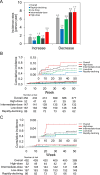Trajectory analysis of glucocorticoid treatment highlights issues in the current tapering strategy for polymyalgia rheumatica
- PMID: 40713161
- PMCID: PMC12306314
- DOI: 10.1136/rmdopen-2025-005650
Trajectory analysis of glucocorticoid treatment highlights issues in the current tapering strategy for polymyalgia rheumatica
Abstract
Objectives: To identify glucocorticoid (GC) treatment patterns in patients with polymyalgia rheumatica (PMR) and explore patient profiles that may benefit from GC-sparing interventions.
Methods: This descriptive study was conducted using an electronic medical record database in Japan. We identified patients with PMR aged ≥50 years who were initiated 5-<30 mg/day of GCs with increased inflammatory markers. Group-based trajectory modelling (GBTM) was used to characterise GC treatment patterns over 52 weeks. We analysed clinical characteristics, including changes in GC doses, longitudinal C-reactive protein levels, immunosuppressant use and GC-related toxicities.
Results: Among 452 eligible patients with PMR, four treatment trajectories were identified: rapidly-declining (19.0%), low-dose (36.9%), intermediate-dose (32.5%) and high-dose (11.5%). The rapidly declining and low-dose groups had more patients aged ≥80 years and with comorbidities. The median doses at week 52 in the low-dose, intermediate-dose and high-dose groups were 3.0, 4.0 and 7.5 mg/day, respectively. These groups had higher cumulative doses and greater GC-related toxicities compared with the rapidly declining group, which was reduced to 0 mg/day by week 8. The cumulative incidence of immunosuppressant use at week 52 was 6.1%-10.5%, even in the high-dose group.
Conclusions: GBTM analysis indicates that many patients who do not discontinue GC use within 1 year are exposed to high cumulative GC doses, which are associated with an elevated risk of GC-related toxicities. Our findings highlight the need to reconsider treatment strategies for patients with PMR, including the use of GC-sparing agents.
Keywords: Glucocorticoids; Polymyalgia Rheumatica; Treatment.
© Author(s) (or their employer(s)) 2025. Re-use permitted under CC BY-NC. No commercial re-use. See rights and permissions. Published by BMJ Group.
Conflict of interest statement
Competing interests: Y. Tanaka has received speaking fees and/or honoraria from Abbvie Inc., Eisai Co. Ltd., Chugai Pharmaceutical Co. Ltd., Eli-Lilly and Company, Behringer-Ingelheim GmbH, GlaxoSmithKline PLC, Taisho Pharmaceutical Holdings Co. Ltd., AstraZeneca PLC, Daiichi-Sankyo Co. Ltd., Gilead Sciences Inc., Pfizer Inc., UCB Japan Co. Ltd., Asahi Kasei Pharma Corporation, Astellas Pharma Inc.; and received research grants from Behringer-Ingelheim GmbH, Taisho Pharmaceutical Holdings Co. Ltd., Chugai Pharmaceutical Co. Ltd. T. Takahashi and K. Sakamoto are employed by Asahi Kasei Pharma Corporation. T. Fukasawa is employed by JMDC Inc., which has receivedfunding for this research from Asahi Kasei Pharma Corporation; he has received research funds from AstraZeneca K.K., consulting fees from Asahi Kasei Pharma Corporation and Real World Data Co., Ltd., and honoraria from EPS Corporation and the Research Institute of Healthcare Data Science; he was previously employed by the Department of Digital Health and Epidemiology at Kyoto University with support from Eisai Co., Ltd. and Kyowa Kirin Co., Ltd. S. Inokuchi, H. Uenaka, A. Fujita, and K. Shimamoto are employed by JMDC Inc., which has received funding for this research from Asahi Kasei Pharma Corporation.
Figures




References
-
- Dasgupta B, Cimmino MA, Maradit-Kremers H, et al. 2012 provisional classification criteria for polymyalgia rheumatica: a European League Against Rheumatism/American College of Rheumatology collaborative initiative. Ann Rheum Dis. 2012;71:484–92. doi: 10.1136/annrheumdis-2011-200329. - DOI - PMC - PubMed
MeSH terms
Substances
LinkOut - more resources
Full Text Sources
Medical
Research Materials
Miscellaneous
